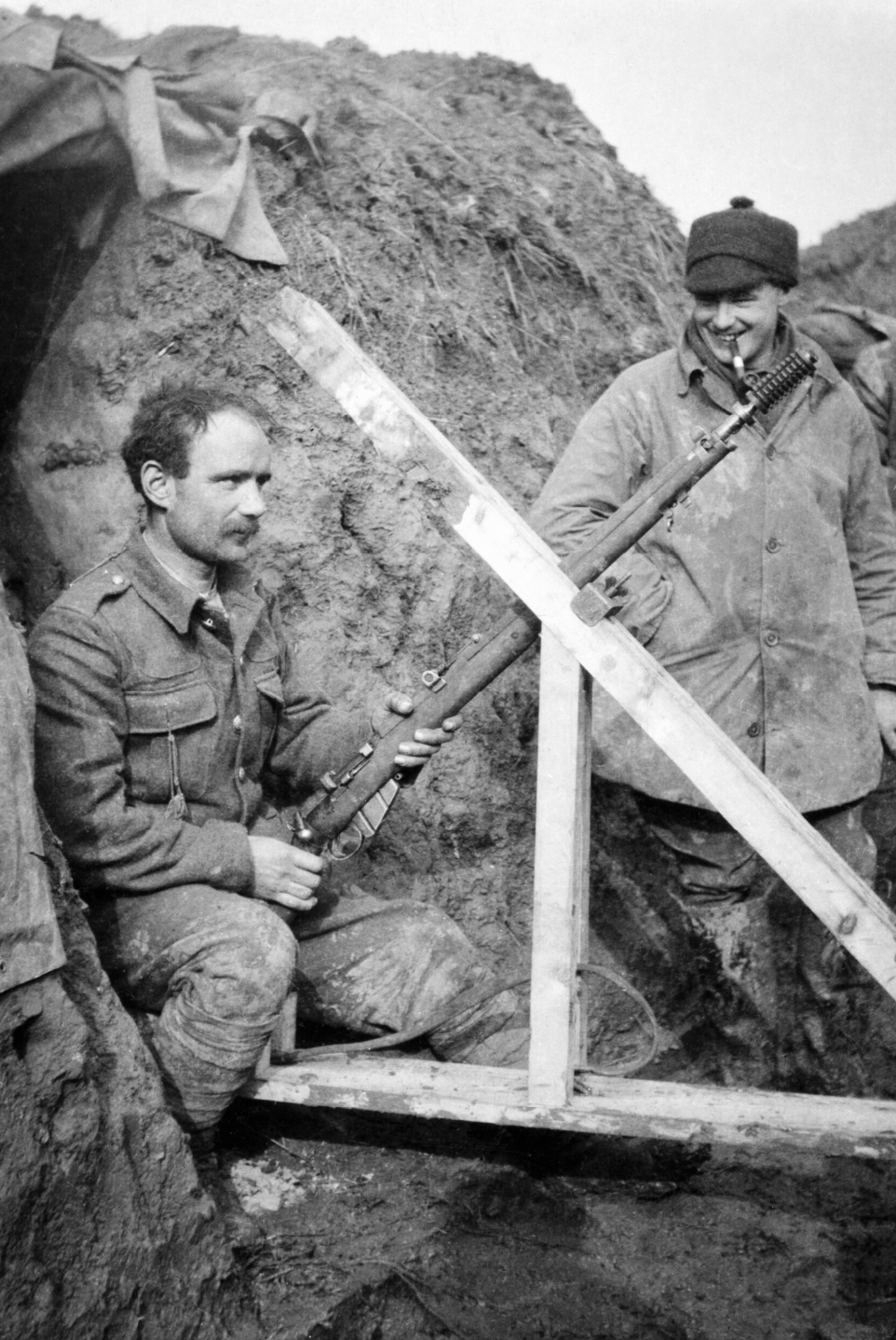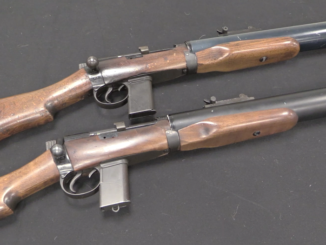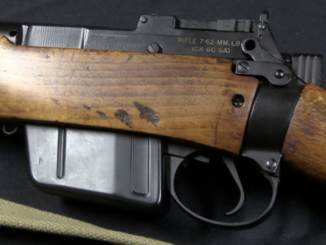The Sten MkI had barely been approved for production when the Sten MkII was born. Initially requested to produce a version of the gun suitable for paratroopers, in March 1941 Harold Turpin redesigned the front end of the Sten to have a quickly detachable barrel and a rotating magazine well (for compact storage). This new model was tests in late June and early July, approved for use, and contracts for it were issued in August 1941.
Named the MkII, this model of the Sten would quickly become the standard, and it was ultimately produced by six major factories (with the assistance of hundreds of subcontractors) on three continents to the tune of 2.6 million examples made. In addition to the barrel removal, the new model has a simpler front sight, simpler stock, and a revised bolt locking notch (upward, instead of downward like on the MkI).
Many thanks to the Royal Armouries for allowing me to film and disassemble these submachine guns! The NFC collection there – perhaps the best military small arms collection in Western Europe – is available by appointment to researchers:
https://royalarmouries.org/research/national-firearms-centre/
You can browse the various Armouries collections online here:
https://royalarmouries.org/collection/




I have a John Norell made MkII. Super fun to shoot and a very easy gun to teach beginners full auto submachine gunning. With a red dot mounted it’s my current open-bolt optics div gun, (soon to be replaced by another MkII I got now becoming a Sterling MkIV). Also have a MkV done by Charley Erb and looking for a Lanchester. A British subgun without a bayonet is improperly dressed!
improperly dressed. lol very good
Joke, “How are British machine carbines like the British royal family? Both are basically German!” Till next my fellow Emma Gees!
Although to be fair George the V did, with ruthless haste; ditch his German family… Albeit he was asked, but he did it wholeheartedly at a personal loss. And really went full on, about beating Germany albeit to great loss; of everyone else. Not a job I would like, being George the V… One of my favorite Kings for that; wasn’t supposed to be King, then entered an absolutely turbulent world with him holding significant power… But he won, took it out of him
clearly; personal relationships, with his Son, etc, etc. But… Some last of the “Kings” I think I.e. He had a lot of power, then. And fate, dictated the time he was living in… My point is, he really went anti German/Family; to win, the British Empire won. That was his job.
Just saying, interesting chap; with a horrid set of circumstances.
Think my point is, there had not been a King dumped on by the fate of just being alive at that point in that position with that amount of “Terrible stuff” in your In Tray, for a very long time. And he, he just went for Victory to the British empire no matter the cost to him & everyone else… A historical epitaph, if you will; he just did his horrid duty 100%.
Picklehaubes, mention of in another thread probably set me off there: https://youtu.be/SBCd9HNV0XU?feature=shared Monty Burns’s “Army”
(I did initially think him a bit of a brute, quite; but if you read back, Fred the 3rd of Prussia it had been… Well it wasn’t going to work; and thus he went for the win – Wilhelms war economy of Turpitz, was only going one way. They do tend to war economies eh, end up in wars.)
And the German Navy scuttled itself in the end, a waste of life; leading to Adolf, with another war economy. I do worry about Russia now accordingly.
I think, the main point of “History” is no matter how much is written, perhaps the element of farce/the every day is missing I.e. One may think these big conflicts of the past where not just stumbled into by Boris Johnson types and our Parliamemt being a bit daft… You may think surely something happened, other than the mundane general everyday nonsense to arrive at these catastrophic outcomes. But you know, it wasn’t black & white to them; the sun was shinning, it was just that day.
Just that day… Which we now look back on as WW1 etc, etc. Stumble into it.
“(…)war economy of Turpitz(…)”
What is this?
“(…)George(…)V(…)last of(…)lot of power(…)”
Now I am confused, considering that according to https://en.wikipedia.org/wiki/Constitutional_monarchy …Queen Victoria was the last monarch to exercise real personal power…
Which leads to the unanswered question as to why did Victoria’s successors go along with the loss of personal power?
“(…)Sten MkI had barely been approved for production when the Sten MkII was born(…)”
Note that this still is not record for next Mark of British weaponry in WW2. This goes to BESA tank machine gun http://www.acant.org.au/Articles/BesaMGs.html
…Mark I and Mark II were both introduced in June 1940, with the Mark I being declared obsolescent on the same day…
For a contemporary view.
In Orwell’s 1942 war diary (while he was active in the Home Guard)
7 August
Last night for the first time took a Sten gun to pieces. There is almost nothing to learn in it. No spare parts. If the gun goes seriously wrong you simply chuck it away and get another. Weight of the gun without magazine is 5½ lb—weight of the tommy gun would be 12-15 lb.Estimated price is not 50/- [shillings] as I had imagined but 18/-. I can see a million or two of these things, each with 500 cartridges and a book instructions, floating down all over Europe on little parachutes. If the Government had the guts to do that they would really burned their boats.
9 August
Fired the Sten gun for the first time today. No kick, no vibration, very little noise, and reasonable accuracy. Out of about 2500 rounds fired, 2 stoppages, in each case due to a dud cartridge—treatment, simply to work the bolt by hand.
22 September
Most if the ammunition for our Sten guns is Italian, or rather made in Germany for Italy. I fancy this must be the first weapon the British army has had whose bore was measured in millimetres instead of inches. They were going to make a new cheap automatic weapon, and having the vast stocks of ammunition captured in Abyssinia handy, manufactured the guns to fit the cartridges instead of the other way about. The advantage is that the ammunition of almost any continental sub-machine gun will fit it. It will be interesting to see whether or Japanese come out with a .303 weapon to fit captured British ammunition.
Ironically, they already had one.
https://en.wikipedia.org/wiki/Type_92_machine_gun
Yes, the IJA and IJN had two different, non-interchangeable 7.7mm rifle cartridges.
7.7 x 58mm Arisaka
https://en.wikipedia.org/wiki/7.7%C3%9758mm_Arisaka
7.7 x 53Rmm Navy (0.303in Enfield)
https://en.wikipedia.org/wiki/.303_British#Japanese_7.7_mm_ammunition
Being a quartermaster on that side must have been interesting to say the least.
clear ether
eon
And Orwell was correct about Stens being parachuted to resistance groups. The logic of 9mm Parabellum already being common on the Continent.
The Sten MK II was preferred to the later MK III, because while the MK II could be broken down into four groups (receiver, barrel, stock, magazine) none more than about a foot long, the MK III could only be broken down into three components (receiver plus barrel in single group, stock, magazine) making it more difficult to conceal.
The MK II could be hidden in a typical leather or canvas haversack that farm laborers used to carry their lunch in, or a bicycle “saddle bag”. The MK III needed a bit more inventiveness to hide. It was deemed better suited to rural activity as opposed to urban areas.
Although the rural resisters really wanted rifles, for obvious reasons. SMGs are good for road ambushes, but for serious sniping, a rifle is pretty much a necessity.
cheers
eon
Broken down for some clandestine stuff sounds like very niche application. Seriously, if regular soldiers carried it in hundreds of thousands, maybe 1% of them needed this hidden resistance stuff. Also, I suspect there was waaaay more Sten made, then directly used. Brits ofc didnt win the war with submachineguns.
But nevertheless, it was fairly good design choice, beside clunky ergonomics.
“(…)more Sten made, then directly used.(…)”
https://www.militaryfactory.com/smallarms/detail.php?smallarms_id=68
Says about more than 4000000 various Marks of STEN made by 1945.
https://www.statista.com/statistics/579773/number-of-personnel-in-uk-armed-forces/ states that Number of personnel in the armed forces of the United Kingdom for 1945 was 4906400. It would be possible to equip more than 80% of them into STEN machine carbines, which certainly far more than actually needed.
If Orwell was right about it, the Sten was amazingly cheap. I had always thought it cost 50 shillings. Back then £1 bought $4, so an 18 shilling Sten would have been worth $3.60. Given that the M1928 Thompsons Britain was buying cost $250 the savings were immense.
According to https://defenceobserver.ca/2023/04/sten-gun/
Sten, with its stamped metal parts, cost $11 while the U.S.-made Thompson submachinegun had a price tag of $70.
which would mean ~6 STEN for 1 Thompson, though it does not precise which Thompson exactly. Also keep in mind that whilst British did purchased Thompson sub-machine guns, most were actually borrowed via Lend-Lease Act, as according to https://smallarmsreview.com/a-phoenix-from-the-ashes-the-thompson-submachine-gun-in-world-war-ii/
By the time the Lend-Lease Act was enacted in March of 1941, the British had initiated eleven contracts in which they purchased 108,000 Thompsons directly from the Auto-Ordnance Corporation. By the end of 1944, the British had also received approximately 406,000 additional U.S. 1928 A1 and M1-M1A1 Thompson submachine guns through the United States’ Lend-Lease Act.
It would be interesting to see how cheap today you could make it, not some small machine shop, but whole factory with expensive stamping tools.
All small parts, even bolt, beside barrel could be metal injection molded. Magwell and dust cover could even be plastic.
https://youtu.be/d3hAnAnJwyU?feature=shared
Space junk, people. You, yes you can make a Difference to Xi, Biden, Vlad, bb’s balloons send them forth. Destroy, what? Shit your parents never had; was a better world?
Space junk; whips round @ turbo knots, a wee bb goes straight through.
Think about it, what’s monitoring your .22 rimfire use etc. And bumping up prices? Aye, them… Was on the Simpsons Major league baseball. So fact.
I am not sure what are you proposing. Please be more lucid.
I learned some new facts about the Sten Mk II from this. I had not known about the different charging handles from different manufacturers, nor that there was a way to secure the charging handle forward, in at least some Stens.
I once had the opportunity to test fire a Canadian Sten Mk II, and it seemed to be a very well made gun, less crude that some of the British ones. It had the skeleton butt, which was comfortable to use, I don’t know why they continued to use the T stock, I have never tried one, but that triangular “grip” looks uncomfortable to say the least.
What about the magazine loader
The Mk III is much simpler to make than Mk II. That made the title of the episode rather underwhelming.
I should note I have Laidler’s book and expected better from Ian. Not mentioning that the Mk III was even simpler was a significant fail.
Wait for the episode on the Mk III.